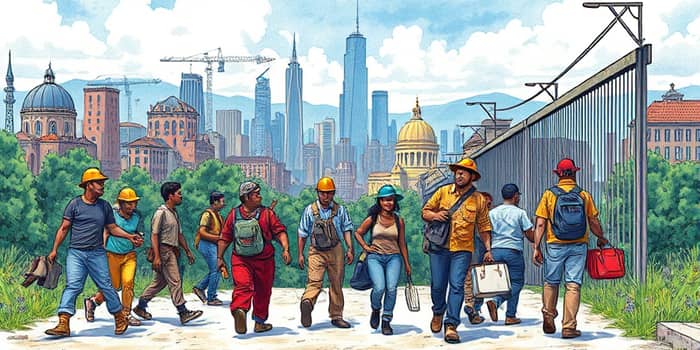
Migration policy in the United States has swung dramatically over the past decade, with each administration introducing measures that ripple through labor markets and communities. This article examines how recent shifts in asylum rules, deportation priorities, and refugee caps have reshaped the availability and dynamics of the American workforce.
From border enforcement to family reunification programs, the policy pendulum influences job vacancies, wage trends, and long-term economic output. By exploring data, regional differences, and political debates, we will understand both the benefits and the challenges posed by fluctuating migration rules.
The Biden administration reversed many restrictions from the previous era, aiming to expand legal avenues for migrants and alleviate labor shortages. Key actions included:
Responding to historic surges at the southern border, new asylum rules introduced transit bans and temporary bars during excessive crossings. These measures sought to manage inflows while preserving legal pathways.
Meanwhile, the Trump administration’s second term has proposed more restrictive steps:
As of mid-2023, there were 13.7 million unauthorized immigrants in the U.S. Since January 2022, approximately 4.91 million people have immigrated, causing the foreign-born share of the labor force to rise from 0.6% to 1.9% by October 2024. Some estimates suggest it could be as high as 3.7% once undercounts are considered.
Projections from the Congressional Budget Office indicate the U.S. labor force will be 5.2 million people larger by 2033, primarily driven by higher net immigration. This demographic shift has both immediate and long-term implications for industries facing chronic labor shortages.
Changes in immigration levels have a measurable impact on key indicators. Between 2017 and 2021, low inflows pushed the vacancy-to-unemployment ratio up by 5.5 percentage points, reflecting tighter labor markets. The strong rebound in 2022 reversed this trend, cutting the ratio by 6 points and easing pressure on job openings.
Immigrant workers filled an estimated 2.5 million jobs in 2022 and an additional 1.5 million in 2023, significantly reducing vacancy rates in sectors like construction and hospitality. Unemployment among recent arrivals does trend higher, and had all undercounted migrants been included, the official unemployment rate would have risen by 0.10 points to 4.24% in October 2024.
Wage growth has decelerated where immigrant shares rose most sharply. Industries such as construction and manufacturing saw wage increases slow by 0.7 percentage points for every one-point increase in workforce share. At the national level, the expanded labor pool has contributed to elasticity of labor supply eases inflation and supports broader economic output.
Immigrant inflows are not uniformly distributed. States like California, Arizona, New Jersey, and Connecticut experienced the largest drops in vacancy rates and the greatest slowdowns in wage growth. Other states, such as Minnesota and West Virginia, saw more modest effects due to smaller increases.
Sectors with the highest immigrant workforce growth include:
In construction and manufacturing, the surge of new workers helped fill critical roles but also tempered wage acceleration, illustrating how labor supply adjustments can yield mixed outcomes across industries.
Persistent congressional deadlock has prevented comprehensive reform, shifting the balance of power to executive actions. This volatility creates uncertainty for employers, migrants, and labor markets alike. Programs for “twilight” legal statuses (e.g., DACA, TPS) face ongoing threats, leading to fluctuating work authorizations and benefit eligibility.
Local governments and service providers often struggle to respond to sudden inflows or policy shifts. Without centralized coordination, cities can be overwhelmed, straining housing, healthcare, and social services. Proposals for federal-state cooperation aim to match migrants to communities with needs and optimize resource allocation.
Data limitations further complicate analysis. Surveys like the Current Population Survey undercount recent immigrants due to language barriers and participation reluctance. Reliable measurement is critical to assess true labor market impacts and craft effective policy responses.
As the U.S. grapples with aging demographics and skill shortages, well-managed migration can be a valuable tool to sustain economic growth. Building robust legal pathways, investing in integration programs, and coordinating federal, state, and local efforts are essential steps.
Future policy debates must weigh economic benefits against social costs and address the human dimensions of migration. By fostering inclusive systems that support both migrants and native-born workers, policymakers can harness the full potential of an expanded labor force while mitigating challenges.
Ultimately, adaptive migration policies—grounded in data and collaboration—hold the promise of a stronger, more resilient economy. The decisions made today will shape labor supply trends for decades, underscoring the high stakes of migration policy adjustments.
References













